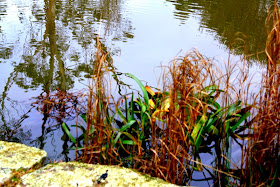I'm sort of on holidays and was lucky enough to be able to go along to a talk organised by the Tamar Natural Resource Management about Tasmanian bush food. We met in the beautiful Punchbowl Reserve, yet another stunning natural feature right in the heart of our city; I don't think we realise how lucky we are.
The talk was given by Kris Shaffer, a keen propagator and user of bush food, her knowledge has been honed by a lifetime of reading and research. She is also an artist and is deeply in tune with the spiritual nature of her environment and the dreamtime of the aboriginal people.
She set a lovely table display and included some of the mainland bush foods in her talk as well. Displayed here on an emu skin is an emu egg, an abalone shell and ringed all around scallop shells containing seeds, pepper berries, wild rice, flowers, leaf tips and other berries; useful for flavouring but not sustaining. Much laboratory research however is going into the potential medicinal properties of some of these edibles.
Here the ripe purple/blue oval fruit of Billardiera longiflora, may be used in jam but not particularly edible raw.
We ground some native Tasmanian pepperberries and I have written a post here previously about using the berries and leaf here. (Kris gave little information about them other than they can be used for flavouring) They are hot, as you would imagine, and have a smoky spiciness. A male and female plant are required for berries so if you are purchasing plants make sure this requirement is met. I think they make a nice addition to the garden as a shrub and can be kept well trimmed in size.
In the very first collage it is wattle seed being ground in the mortar. Again, we were not given information about the species and were warned that the extraneous matter inside the seed pod could be carcinogenic.
Above left was a loaf of bread that Kris made flavoured with leaf tips from Baeckea gunniana. I tasted a tiny piece of leaf and experienced a very pungent strong flavour. My immediate impression was that it would provide a high yield of essential oils and I got an impression of medicinal qualities for chests, anti-fungal, antiseptic - just impressions. No doubt more lab work is being done on this. Also next to the bread is some bunya nut seeds from the mainland. We used to eat these in QLD, steamed or baked (pierce the shell first!), hot with butter. They are starchy and potatoey with a delicate sweet nuttiness. They grow on very large Bunya trees in big cones like a giant pine cone. When ripe they drop to the ground and we delighted if we ever found some. Many of the trees have been removed as the danger from the dropping cones in public spaces could kill someone and unfortunately though some have been planted in Tasmania, I have never seen one bear fruit here.
Even the waterway running through the gulley that is part of the Punchbowl Reserve had edibles. The green long flat ribbon leafed foliage comes from an edible tuber that tastes like potato chips. It grows prolifically but I didn't catch the name of it.
Kris spoke beautifully and spiritually, showing us continually the connection between all of nature. Looking at the signs and deeper meanings that bind all things together. Harmony is to be found in the way that plants generate, what the animals eat and in their turn propagate. She showed a close interconnection between season and place. However, much of the Pallawa people's knowledge has been lost in the last 200 years of colonisation and people like Kris are gathering, researching and rediscovering. There is also money going into research, potential in commercial crops being looked at, delegations going to China with proposals and talk of intellectual property rights being protected.
We learnt a lot but I felt it was more warm and fuzzy PR than anything specific. We didn't learn about propagation, harvesting, gleaning, cooking, nutrition or medicine. I accept the warnings about potential poisoning and that some foods are safe only after processing or at certain times but that to me is what education safeguards against. As a person who shares a lot of food knowledge I find the concept of food being intellectual property a bit unsettling. I do however believe that the aboriginal community can be relied upon to place a significant emphasis on sustainability and I would welcome any new commercial venture for the Tasmanian economy.
Kris often referred to the book "Land of the Sleeping Gods" and it sounds like interesting reading and I'm putting it on my list.
And check out Kris's Mariner shell necklace
You can read about Mariner necklaces in my post here.









How interesting!
ReplyDeleteMore like fascinating. Ive been following the blog Artist as Family bicycle trip up the east coast and they are foraging up to 15% of their food along the way and its been a real eye opener. Beautiful photography Tanya.
ReplyDeleteThanks for the heads up on that one. A very interesting blog!
DeleteLove the way all the bush food is set out. I must look this book up its something I would love to learn more about. Beautiful post xx
ReplyDelete